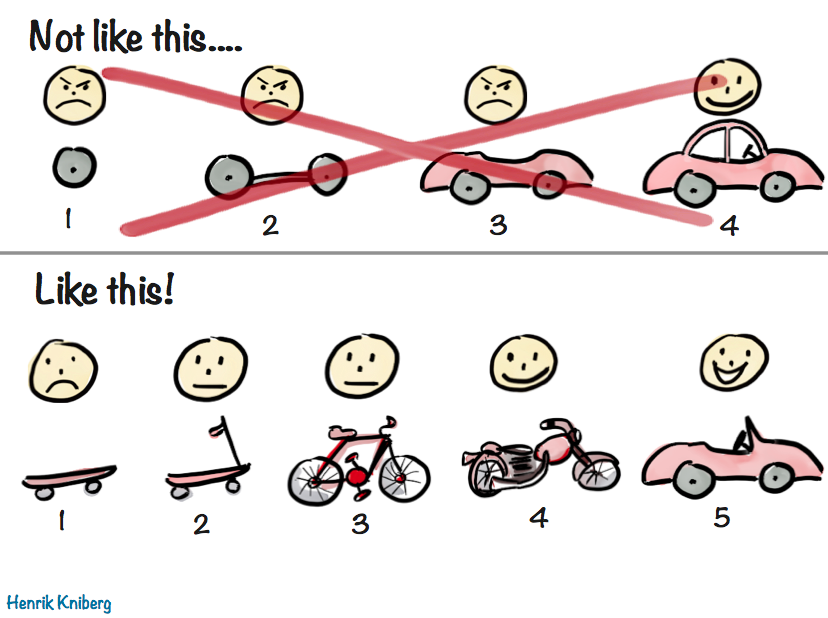
| A bicycle-car |
A former colleague, Neil Schiller, recently wrote an excellent article, https://www.linkedin.com/pulse/agile-data-programmes-neil-schiller/, on the challenge of using agile approaches in data-centric programmes. In it, he referenced and reviewed a classic cartoon by Henrik Kniberg which is often used to promote the advantages of agile delivery:

Now it’s wholly possible that I am reading more into a limited analogy than appropriate, but I think this same diagram can also be used to explain some of the fundamental issues with agile approaches.
Think about what the bottom line is claiming: that by a set of small incremental deliveries we can somehow achieve the equivalent of transforming a scooter into a bicycle, into a motorbike and then into a car, each a fully working vehicle meeting the user’s requirements. In the real physical world this is laughable: each has a wholly different architecture with no commonality whatsoever between equivalent subsystems at any of the stages. Key properties arise from the fundamental structure – a simple tubular chassis for bike, a more complex frame including complex stressed moving parts like the engine and transmission for the motorbike, typically a monocoque chassis/exoskeleton for the car. These underlying elements form the basis, and you have to get them right as you can’t modify them later: you can’t “add strength” to a car by adding more tubes after the event (unless you are going banger racing!).
In the real physical world you create a complex engineered artefact by understanding its required properties, creating a layered structure which is designed to meet them, and then building up those layers to progressively deliver the required result. This requires that the most fundamental, least readily changed layers have to be right, and stable, early on, and only then can you add the upper more flexible elements. The first version of the process in the diagram is actually wholly correct, the second a joke.
Is it so very different for software? If we’re talking about major systems with real-world complexity and non-functional demands, I’m not convinced. The “ultra-agile” argument that it is always possible to “refactor” code to make changes. This is true up to a point, but it can be difficult and costly to change the underlying structure. If that does not meet requirements for security, or reliability, or performance, then no amount of fiddling will fix it, and if changes amount to a fundamental rewrite then it’s difficult to see where any advantage has been gained.
Obviously there are differences. The vehicle designer seeks to both create and use solutions which once right will be re-used many times (from hundreds to millions of instances), but will be difficult to change once in production. Software development is still largely about one-offs. Software requirements are typically less well-defined than for established hardware products. In vehicle manufacture, the roles of engineer/designer and constructor are distinct, whereas in software the designers often have an ongoing role in construction, and may at least subconsciously seek to extend that role (guilty as charged 🙂 ). On the other hand, the car designer knows that an approved design will be built largely as documented, whereas the software designer has no such assurance.
Fundamentally, however, I believe that software development can benefit from engineering disciplines just as much as the design of physical products. For example, it is much better to attempt to understand and predict up front how a given design will respond against non-functional requirements. Testing is a very good way to confirm that your solution basically works and to refine refinements. It is a very bad way to uncover fundamental deficiencies, especially if this occurs late in the development process.
This doesn’t mean that I don’t believe in agile development. Far from it, I am a great believer in iterative and incremental development, and structures such as Scrum sprints to manage them. However, I really don’t believe in architecture “emerging from the code”, just the same as I would not expect to see a great car design “emerge” from the work of a group of independent fabricators working on small parts of the problem without any overarching design. Cars “designed” in such a way tend to be more Austin Allegro (or AMC Pacer) than Bugatti Veyron.
Instead, Architecture has to be understood as providing the structure within which the code is developed, with that overall structure developed using engineering disciplines: assess the various forces on the design, articulate how these forces will be resolved (including what compromises are required), then document and model the solution to predict its properties.
If the requirement is for a sports car, design a sports car, don’t try and “refactor” a pushbike…
Creation of such designs, documents and models is a distinct discipline from coding. Some of this may be the domain of specialists, some may be performed by those who also have other development roles, but as a separate activity requiring appropriate skills and experience. Ironically I think Tom Gilb got it about right in his 1988 book “Principles of Software Engineering Management”, when he defined “Software Engineer” as someone who “can translate cost and quality requirements into a set of solutions to reach the planned levels”, and who has the skill to change any given quality dimension of a system by a factor of ten if required. The latter challenge would uncover a lot of people who call themselves “architects”.
In addition complex designs need some form of centralised, overall ownership and design control – this again requires specialist skills and cannot just be allocated randomly, but will sit with an Architect and/or a Product Owner.
Within such a framework concepts such as continuous integration and testing still make sense. Development, both functional and non-functional can still be managed via the backlog and sprint plans, epics and stories. However the “minimum viable product” may require completion of much of the underlying architecture as well as major functional capabilities. Major capabilities, both functional and non-functional, have to be analysed and designed up front, not left to stories somewhere in the backlog. The intermediate delivery is a car, albeit incomplete, not a complete bicycle.
Agile development and architecture are not incompatible, but complementary. Successful development of a complex real-world system will inevitably follow the first model in Kniberg’s cartoon, no matter how much the agilists would like it to be the second. At scale, and in the face of more challenging requirements software development needs to be treated as an engineering discipline, with agile structures in service of that discipline, not avoiding it.
 Thoughts on the World (Main Feed)
Thoughts on the World (Main Feed) Main feed (direct XML)
Main feed (direct XML)